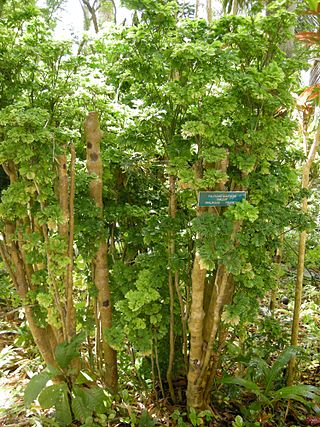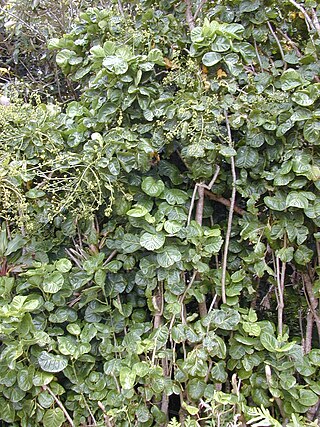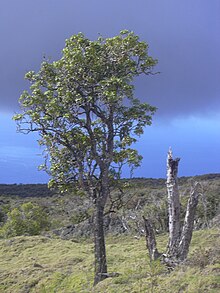Sycamore is a name which has been applied to several types of trees, but with somewhat similar leaf forms. The name derives from the ancient Greek συκόμορος (sūkomoros) meaning "fig-mulberry".

GastoniaCommerson ex Lamarck is a formerly accepted genus of plants in the ivy and ginseng family, Araliaceae. It had been known as an unnatural group, but was recognized as late as 2010, when its nine species were distributed to four different subgenera of the large genus Polyscias. Because the genus Gastonia is now obsolete, its species are herein referred to by their names in Polyscias.

Polyscias racemosa, or false 'ohe, is a species of flowering plant in the family Araliaceae. As Munroidendron racemosum, the species was until recently considered to be the only species in the monotypic genus Munroidendron. With the change in classification, Munroidendron is now obsolete. Polyscias racemosa is endemic to the Hawaiian island of Kauai. It is very rare in the wild and some of its original habitat has been replaced by sugar cane plantations. It was thought for some time to be probably extinct, but was rediscovered a few years prior to 1967.
Arthrophyllum is a defunct genus of plants in the family Araliaceae. It was recognized by most authors until 2010, when all of its 30 species were "sunk" into Polyscias subgenus Arthrophyllum.
Cuphocarpus is an obsolete genus of flowering plants in the family Araliaceae. Mabberley (2008) treated it as a synonym of Polyscias, but other authors still recognized it at that time. In 2010, in a phylogenetic analysis of DNA sequences, it was shown that Cuphocarpus was biphyletic and embedded in the large genus Polyscias. In an accompanying paper, Polyscias was divided into 11 subgenera, with seven species left incertae sedis.
Reynoldsia is a formerly recognised genus of plants in the ivy family, Araliaceae. In 2003, Kew Gardens published a checklist for Araliaceae, in which eight species were recognized for Reynoldsia: four from Samoa, two from Tahiti, one from the Marquesas, and one from Hawaii. In 2010, a phylogenetic comparison of DNA data showed that Reynoldsia was polyphyletic, consisting of two groups that are not each other's closest relatives. In a companion paper, three of the species were "sunk" into synonymy with others, reducing the number of species to five. All species that were formerly in Reynoldsia are now in Polyscias subgenus Tetraplasandra, a subgenus of 21 species indigenous to Malesia and the Pacific islands.
Tetraplasandra is a no longer recognised genus of plants in the ivy family, Araliaceae. They are small to medium trees, of mesic to wet forests.

Aralioideae is a subfamily of flowering plants contains around 50 recognized genera. These include the genus Panax, to which ginseng belongs. Other notable species are the Angelica-tree, the devil's club, or common ivy.
Kokia kauaiensis, the Kauai treecotton or Kauaʻi Kokiʻo, is a species of flowering plant in the mallow family, Malvaceae, that is endemic to Kauaʻi, Hawaii.

Polyscias rodriguesiana is a rare species of plant in the family Araliaceae.

Melicope knudsenii, commonly known as Olokele Valley melicope or Knudsen's melicope, is a species of flowering plant in the family Rutaceae, that is endemic to Hawaii. It inhabits montane mesic forests dominated by Acacia koa, Metrosideros polymorpha, and Dicranopteris linearis on Kauaʻi and East Maui (Auwahi). Associated plants include Syzygium sandwicensis, Cheirodendron trigynum, Myrsine lessertiana, Ilex anomala, Alphitonia ponderosa, Zanthoxylum dipetalum, Kadua terminalis, Pleomele aurea, Bobea spp., Tetraplasandra waimeae, Xylosma hawaiensis, Eurya sandwicensis, Psychotria mariniana, Melicope anisata, Melicope barbigera, Planchonella sandwicensis, Dodonaea viscosa, and Dianella sandwicensis. It is threatened by habitat loss. Like other Hawaiian Melicope, this species is known as alani. This is a federally listed endangered species of the United States.

Polyscias sandwicensis, known as the 'ohe makai or ʻOhe kukuluāeʻo in Hawaiian, is a species of flowering plant in the family Araliaceae, that is endemic to Hawaii. It is a tree, reaching a height of 4.6–15 m (15–49 ft) high with a trunk diameter of 0.5–0.6 m (1.6–2.0 ft). It can be found at elevations of 30–800 m (98–2,625 ft) on most main islands. Polyscias sandwicensis generally inhabits lowland dry forests, but is occasionally seen in coastal mesic and mixed mesic forests. It is threatened by habitat loss.

Sapindus oahuensis is a species of tree in the soapberry family, Sapindaceae. It is endemic to Hawaii, where it is limited to Kauaʻi and Oʻahu. Its common names include Āulu, Oahu soapberry, alulu, kaulu, and lonomea.
Polyscias gymnocarpa, commonly known as the Koolau Range 'ohe or Koʻolau tetraplasandra, is a species of flowering plant in the family Araliaceae, that is endemic to the Hawaiian island of Oʻahu. It is threatened by habitat loss.

Polyscias fruticosa, or Ming aralia, is a perennial plant, dicot evergreen shrub or dwarf tree native to India. The plant grows fairly slowly but can reach up to 1 to 2 meters in height. The leaves are of a dark green pigment, glossy in texture, and are tripinnate and appear divided. Individual leaves vary from narrowly ovate to lanceolate and are about 10 cm long.

Polyscias guilfoylei, the geranium aralia or wild coffee, is a species of evergreen shrub native to the paleotropics and neotropics. It is not closely related to the true coffee plants of the genus Coffea. It has erect branches and can grow to a height of up to 24 ft (7.3 m). The leaves are long and 1-pinnate with leaflets which are opposite. The leaf blades are variable, but usually ovate or elliptic and coarsely dentate or lacerate. The leaves are commonly variegated with margins of white or pale yellow, but can also be entirely dark green.

Lobelia oahuensis is a rare species of flowering plant in the bellflower family known by the common name Oahu lobelia. It is endemic to Hawaii, where it is known only from the island of Oahu. There are about 100 individuals remaining in the Koʻolau Range, and only one known individual in the Waianae Range. It is federally listed as an endangered species of the United States.

Viola oahuensis is a rare species of flowering plant in the violet family known by the common name Oahu violet.

Polyscias scutellaria, the shield aralia, or plum aralia, is a tropical shrub or small tree reaching 2–6 meters in height. A native of the Southwest Pacific islands, it is commonly grown in gardens.

Polyscias flynnii is a plant species endemic to the island of Kauai in Hawaii. It is rare, found only in one population covering about 1 km2 in the Kalalau Valley. It is regarded as threatened. It is threatened by feral goats and non-native plant species in its habitat. It was federally listed as an endangered species of the United States in 2010.














